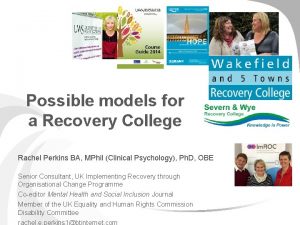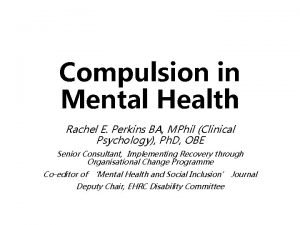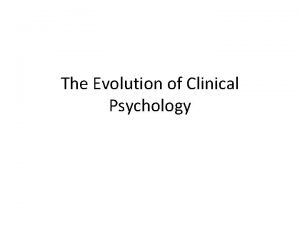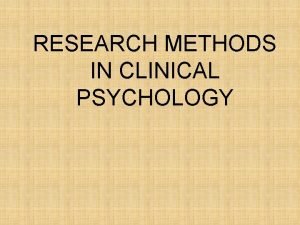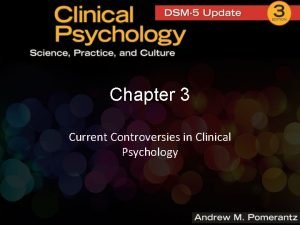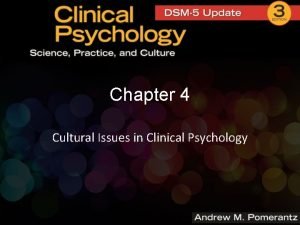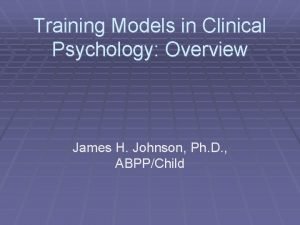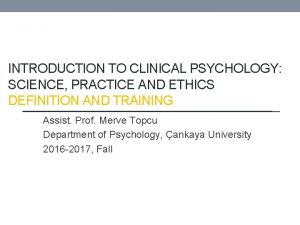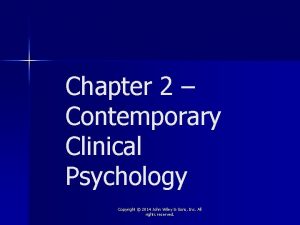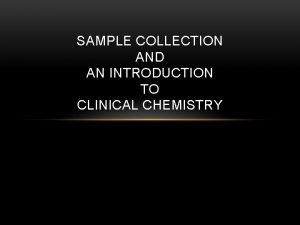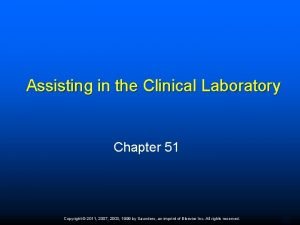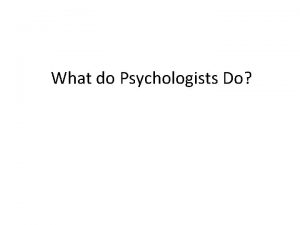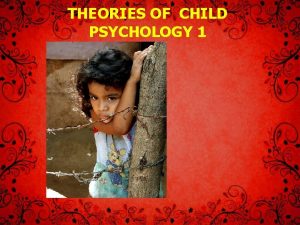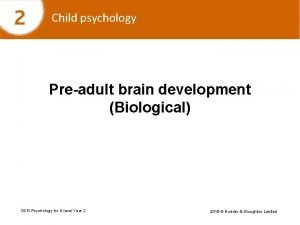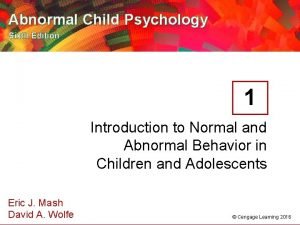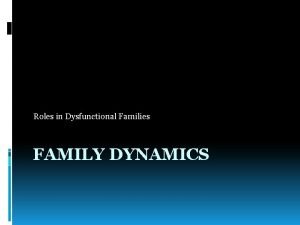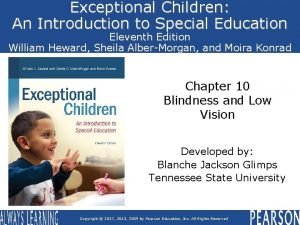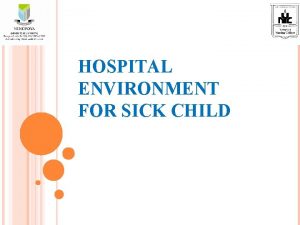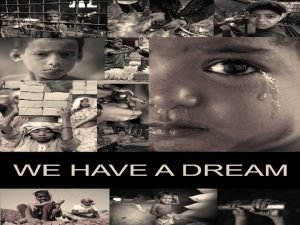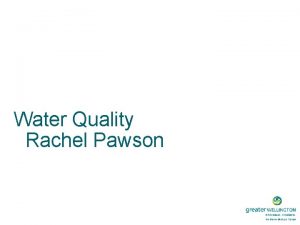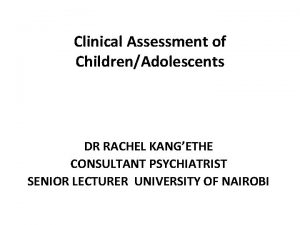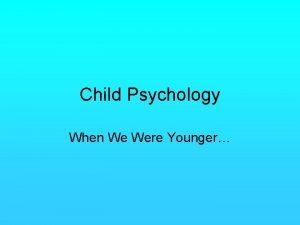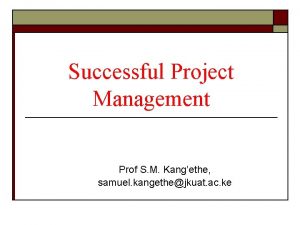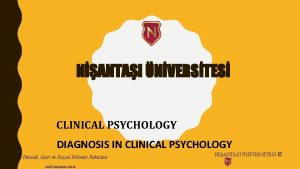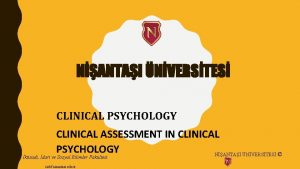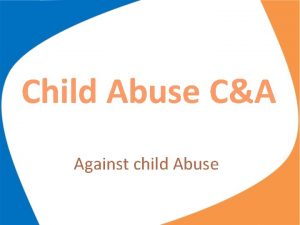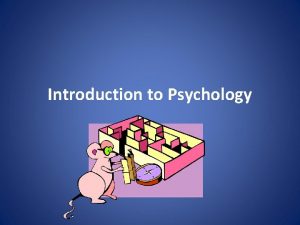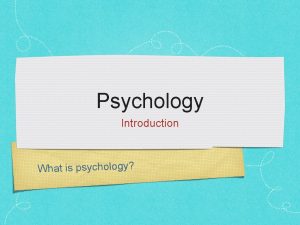Introduction to Clinical Child Psychology DR RACHEL KANGETHE



































- Slides: 35

Introduction to Clinical Child Psychology DR RACHEL KANG’ETHE Consultant Psychiatrist/Senior Lecturer University of Nairobi


What is Clinical Psychology? • Clinical Psychology is the largest sub -discipline of psychology. The goal of psychology as a field is to “study and understand” behavior • Take a minute to think about what you know about clinical psychology and on a piece of paper complete the following sentences. 1. “CLINICAL PSYCHOLOGY IS ………… ” 2. “CLINICAL CHILD PSYCHOLOGY IS …. ”


WHY ATTEND TO CHILD ISSUES/DISORDERS? Ø Magnitude of childhood psychopathology. Developed countries studies indicate 14 - 20% children have psychiatric disorders. Data from developing countries suggests a similar picture [R. Kang’ethe, 1990]. • 2016, Kenyan population ~ 47 588 092 • under 15 yrs (42%) • 14 - 20% children have psychiatric disorders, that is 2. 8 - 4 m children

WHY ATTEND TO CHILD ISSUES/DISORDERS 2 ØIn addition to its substantial magnitude, evidence shows child psychopathology is interrelated with other youth/child-related problems eg, school violence, SUDs, etc. ØFurthermore many childhood disorders have lifelong consequences. ØMost adult disorders have their roots in childhood disorders. ØCare of child psychopathology benefits children, families, adult psychopathology, economy, future.

Brief Hx of Clinical Child Psychology (CCP) Thro’ 20 th century, child psychopathology largely ignored -“adult morphism” • 1896: Lightner Witmer-1 st psychology clinic to treat children with learning disabilities. • 1916: Binet-Simon Scale brought to USA • 1946: Formal clinical psychology programs began • 1953: American Academy Child Psychiatry • 1980: DSM 3 -diagnostic criteria for children • Now: DSM-IV consists of over two dozens disorders specific to childhood disorders

Clinical Child Psychology (CCP): Overview • CCP represents a merging of basic psychological principles with the core features of both clinical and developmental psychology with a thorough background in child and family development. • Major focus is understanding, preventing, diagnosing & treating psychological, cognitive, emotional, behavioral developmental & family problems of children. • Population served: Infants (birth-3 yrs), children (3 -9 yrs), adolescents (10 -18 yrs) & importantly, families (parents/other caregivers, sibs)

Core activities done by Child Clinical Psychologists 1. Practitioners (assessment and intervention) a) Assessment - e. g. , DSM-5 diagnoses, IQ, etc. b) Intervention e. g. , home or school based therapy 2. Researchers 3. Supervisors and teachers 4. Program development (prevention, Rx, evaluation) a) Prevention (e. g. , DM management, bullying) b) Treatment and program evaluation 5. Consultants (schools, NGOs/government agencies) 6. Advocacy

Clinical Child Psychology CCP Practice Settings • Private practices • Counseling centers • School/Universities settings • Hospital settings • Military/Government • Community agencies • Juvenile justice system • Advocacy organizations • Research Centers Types of Problems can be: • Biological • Emotional • Social • Behavioral • Developmental • Health-related • Academic • Family-based

TYPES OF PROBLEMS - HIGHLY VARIED • High risk children compromised by biological vulnerabilities or psychosocial adversity (e. g. , preterm, medically ill, drug-addicted newborns or cognitive deficits) • Common childhood problems or parenting issues (tantrums, toilet training, sleep or feeding problems in toddlerhood) • Psychiatry morbidity (e. g. , schizophrenia, mood disorders, autism, etc)

TYPES OF PROBLEMS - HIGHLY VARIED 2 • High risk behaviors (delinquency, SUDs, sexual behaviors) • Coping with stressful life events (e. g. , divorce, singleparenting, custody arrangements, step-parenting) • Coping with a chronic, serious or life-threatening physical illnesses (e. g. , childhood cancer, diabetes) • Adherence to medical regimens

CHILDREN AND ADOLESCENTS

Theoretical and scientific knowledge fundamental to child clinical psychology 1. 2. 3. 4. 5. Normal child development Family processes Child and adolescent psychopathology Developmental psychopathology Research design/methodology and outcome research 6. Ethical issues with confidentiality/informed consent with minors

1. Knowledge of normal developmental processes as ~ relate to emotional, behavioral & social functioning. • Distinguishing between normal and abnormal behavior and development • Understanding developmental factors as they relate to assessment and intervention • Common behavioral, social, and emotional problems are often correlates of normal behavior 2. Fly processes relating to child's development • Impact of family dynamics, normal family functioning and childrearing practices on normal child development and on the development of problems.

3. Child psychopathology knowledge: § Epidemiology of children's problems and risk factors § Etiological models & classification of problems-DSM § Developmental issues related to the assessment and classification of child's problems § Treatment options as they relate to specific childhood problems and children of different ages § Knowledge family/other problems requiring treatment. 4. Developmental psychopathology § Combines research and theory on normative developmental processes, the developmental course of disorders in children, and intergenerational transmission of maladaptive behavior patterns.


5. Ethical and legal issues related to informed consent and confidentiality with vulnerable populations that require special considerations § Infants, toddlers, preschoolers who cannot give consent § Children who have been sexually/ physically abused § Children involved in custody battles § Young children who are abusing substances 6. Research methods and design: • The ethics of conducting research with children who can give assent but not consent to participate and young children who cannot give consent or assent

PLAY

DIFFERENTIATING Cl. PSYCHOLOGY FROM PSYCHIATRY Psychiatry • Can prescribe medication • Medical school training emphasizing biology, chemistry, etc. • “When they are through with their training they take an oath. When CP are through they get into an argument” --Sandford Goldstone • Psychiatrists learn facts to treat patients, CPs learn to think as researchers, evaluate & defend their views by citing data and using evidence

Clinical Child Psychology vs. Pediatric Psychology Considerable overlap, but… • Clinical Child Psychologists – typically work with children once psychological systems have developed – Usually in private practice or outpatient clinics – Traditional training (assessment, developmental processes, family therapy) • Pediatric Psychology (child health psychology) – Usually practiced in medical settings – Short-term cognitive-behavioral interventions – Tend to emphasize medical and biological issues in training, research and service delivery

CHILDREN PSYCHIATRIC DISORDERS Most common pediatric mental health disorders include: – Anxiety disorders (most common) – Mood disorders – Attention Deficit Hyperactivity Disorders – Autism Spectrum Disorders – Conduct Disorders – Substance abuse Undiagnosed, untreated, or undertreated pediatric mental illnesses have been linked with: • School failure • Suicide • Substance abuse • Violence • Homelessness • Incarceration


• Developed countries studies indicate that 14% to 20% of children have psychiatric disorders. • Data, although limited, from the developing countries also suggests a similar picture [R. Kang’ethe 1990]. • ADHD, Anxiety Disorder, Major Depression, Bipolar disorder, Schizophrenia, Substance Abuse Disorder and Conduct Disorder are common childhood psychiatric disorders.

CHILD VERSUS ADULT PSYCHOPATHOLOGY • Child’s existence and emotional development depends on the family or care givers. • Child seldom initiates consultation • Children less able to express themselves in words • Developmental stages are CRUCIAL in assessment, diagnosis and interventions. • Developmental amplification of child’s primary psychological issues. • Fewer disease entities; more reactions to environmental factors in family/school/neighborhood.

CHILDHOOD STRESSORS • Maladaptive parenting • Birth of a sibling • Exposure to poverty • Starting school • Parental conflict and divorce • Child abuse

Assessment Issues Many techniques, used with adults are used, however: • Cognitive maturation limits usefulness of selfreport data • Majority of referrals from schools, having to do with school-based problems • Almost always include concerns with behavior within the family setting • Issues of confidentiality

TYPES OF REFERRALS • Referral for evaluation and ongoing treatment. • Referral for evaluation and initial treatment with referral back for continued care. • Consultation and an evaluation but without the assumption of ongoing medical responsibility; e. g. , diagnostic clarification, court cases, etc • Consultation and an evaluation with continued multidisplinary team treatment provided togrther with other practitioners. • Consultation without a face-to-face evaluation of the patient. This may occur through a treatment team within a clinic or an intervention team within a school.

• Regardless of the etiology of the primary disorder, biological, cognitive, psychodynamic, familial, social, economic, and cultural factors are critical in determining the course of illness. • The effects of early developmental deficits may be compensated for or exacerbated by later opportunities or barriers. The family or social environment can amplify strengths or aggravate weaknesses. • The adult outcome of a childhood disorder in a specific patient is a result of the interaction between therapeutic forces, risk and protective factors.

Treatment of Child Mental Illness • Though diagnosing mental health problems in young children can be challenging, it is important, as a diagnosis is used to guide treatment and link child's care to research on children with similar problems. • Children are constantly changing and growing, diagnosis and treatment must be viewed with these changes in mind. • Furthermore child psychopathology can exert lasting effects far beyond boundaries of primary morbidity. • Prompt intervention can reduce such developmental consequences.

TREATMENT • Talk therapy not really an option for younger children – verbal skills, insight • Play therapy • Behavior therapy – especially operant procedures • Cognitive-Behavioral Interventions • Biological Interventions – medication, dietary modifications

• The ultimate prognosis may depend more on the ability of child and family to learn to cope with the illness than on the severity of the disorder. • Resilient individuals may even turn childhood symptoms such as excessive sensitivity (separation anxiety) or uncontrolled activity and enthusiasm (ADHD) into strengths in adulthood. • Compensatory abilities and an enhancing environment can result in achievement and adaptation far above that predicted from early deficits.


ASANTE SANA

Questions?
 Dr rachel kangethe
Dr rachel kangethe Rachel perkins clinical psychologist
Rachel perkins clinical psychologist Rachel perkins clinical psychologist
Rachel perkins clinical psychologist Nature and scope of clinical psychology
Nature and scope of clinical psychology Research design in clinical psychology
Research design in clinical psychology Current controversies in clinical psychology
Current controversies in clinical psychology Penn state university clinical psychology
Penn state university clinical psychology Clinical psychology definition
Clinical psychology definition Cultural issues in clinical psychology
Cultural issues in clinical psychology Models of clinical psychology
Models of clinical psychology Masters in clinical psychology uae
Masters in clinical psychology uae Explain methods of psychology
Explain methods of psychology Clinical psychology science practice
Clinical psychology science practice Doctorate in clinical psychology clearing house
Doctorate in clinical psychology clearing house Contemporary clinical psychology
Contemporary clinical psychology Clinical psychology science practice
Clinical psychology science practice 이진트리 복사 순회
이진트리 복사 순회 Introduction to clinical laboratory
Introduction to clinical laboratory Chapter 45 introduction to the clinical laboratory
Chapter 45 introduction to the clinical laboratory Types of child psychology
Types of child psychology Theories of child psychology
Theories of child psychology Types of child psychology
Types of child psychology Types of child psychology
Types of child psychology Equifinality psychology
Equifinality psychology Lost child psychology
Lost child psychology Positive psychology ap psychology definition
Positive psychology ap psychology definition Social behavior psychology definition
Social behavior psychology definition Fundamental attribution error ap psychology
Fundamental attribution error ap psychology Social psychology definition psychology
Social psychology definition psychology Health psychology definition ap psychology
Health psychology definition ap psychology Concept of child health nursing
Concept of child health nursing Modern concept of pediatrics
Modern concept of pediatrics Exceptional children 11th edition
Exceptional children 11th edition Hospitalization of sick child definition
Hospitalization of sick child definition Child labour
Child labour Rachel pawson
Rachel pawson

